

Diary of a WWI German internee who spent time on Bruny Island provides rare insights. In August 1914, news of war trickled down to a German logging ship docked at one of Australia's southern most tips.

World War I relics revealed as melting ice in Italian Alps uncovers century-old barracks. Melting ice in the Italian Alps has revealed a "time capsule" of the daily life of soldiers fighting in World War I.

The glacial melt near the famous Stelvio Pass in northern Italy has revealed a cave shelter used by Austro-Hungarian soldiers, complete with weapons, lamps, eating utensils and corpses. White Australia policy no barrier to Queensland man Billy Sing's World War I feats. He was born William Edward Sing in a small Central Queensland town, but would later become known by many names, including the "Gallipoli Sniper" "Assassin" and "crack shot of the Anzacs.
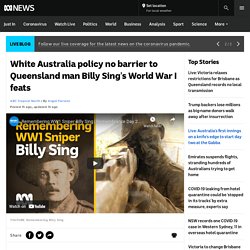
" It was an unlikely fate for Billy Sing, whose part-Chinese heritage initially prevented him from enlisting with the Australian Imperial Force altogether. "That’s not an isolated incident," Veteran and RSL Sunnybank member, Adam Lo, said. Mr Lo, who is also involved with the Chinese Museum of Queensland, said many Chinese Australians would try their luck at different recruitment centres at the time. When World War I broke out, an act of parliament in line with the White Australia Policy prevented any man who was not white from enlisting. Darwin doctor to honour Diggers with Last Post from apartment balcony this Anzac Day. Posted about 3 hours agoThu 23 Apr 2020, 10:38pm Occupants of a Darwin apartment block will get an early awakening on Anzac Day, whether they like it or not, as their resident trumpeter does her dawn-service duty.
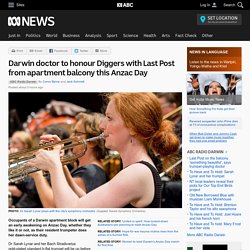
Key Points: Dr Sarah Lynar will be up before dawn to play from her apartment complexThe Darwin Symphony Orchestra trumpeter has played at Anzac Day ceremonies around the worldHer first service was at 12 with her twin sister to a crowd of thousands Dr Sarah Lynar and her Bach Stradivarius gold-plated standard b-flat trumpet will be up before the sun to play reveille and the Last Post from the rear balcony of her Nightcliff apartment, joining thousands of others marking this coronavirus-affected Anzac Day from homes, front yards and driveways across the nation.
The little-known origin of the minute's silence - RN. Posted about 5 hours agoThu 8 Nov 2018, 8:00pm.

Did Hobart's network of coastal defences ever see any action? - Curious Hobart. Posted about 3 hours agoMon 15 Oct 2018, 9:30pm The shores of Hobart's River Derwent are scattered with defunct gun batteries.
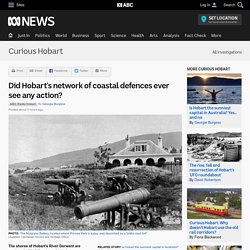
Each tells a story about the threats perceived at a point in history, whether it be in Hobart's early colonial days or during World War II. Hobart's isolation did not make it immune to war and as an important shipping port, it was a target for Australia's enemies. ABC Hobart has been asked by audience members about where the batteries were, what threats were they designed for and if they ever saw action. 'A pitiful mud fort' Hobart's first proper battery was the Mulgrave Battery, located at Battery Point in what's now known as Princes Park.
It was built in 1818 from stone. Once described as a "poor pitiful mud fort", the battery was criticised by those who served there amid concerns the stone would shatter if fired upon. Australians / New Zealanders / ANZACS in the First World War. Journal of the Australian War Memorial. Word Search. Scootle. World War I centenary resources. With the centenary of the First World War set to begin in July this year, many institutions will be launching new sites, programs and resources for schools.
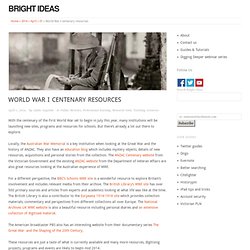
But there’s already a lot out there to explore. Locally, the Australian War Memorial is a key institution when looking at the Great War and the history of ANZAC. They also have an education blog which includes mystery objects, details of new resources, acquisitions and personal stories from the collection. Introduction. On June 28, 1914, the heir to the Austrian-Hungarian throne, Archduke Franz Ferdinand, visited the city of Sarajevo in the province of Bosnia, on the far southeastern tip of his empire.

As the archduke’s car entered the town, six assassins—five of them teenagers—mingled in the crowd awaiting their chance to step forward and kill the aristocrat as he drove by. One assassin threw a bomb toward the car, but the driver saw it coming and sped forward, while the archduke himself deflected the explosive device in the air so that it overshot its target. The bomb blew up behind the car and injured several people, but Franz Ferdinand remained unscathed. The young, unsuccessful assassins scattered. Later that day, however, the archduke’s car took a wrong turn on route to visit the injured bystanders at a local hospital. Mtmariasose10-2 - The impact of WW1 - how it shaped Australian Identity.
Aboriginals who served in WW1. Over 400 Aboriginal and Torres Strait Islander people enlisted and/or served in World War I with some 165 from NSW, from the South Coast and Yuin nation area include: * born in the Milton Ulladulla District In accordance with traditional laws often followed by Indigenous communities in Australia the mentioning of and photographs of deceased people may offend.
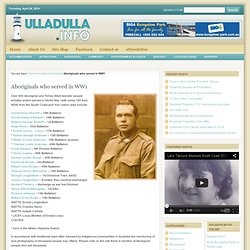
Please note on this site there is mention of Aboriginal people who are deceased. World War One - Weapons. During World War One a variety of weapons were used.
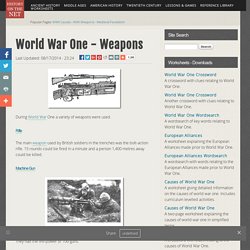
Rifle The main weapon used by British soldiers in the trenches was the bolt-action rifle. 15 rounds could be fired in a minute and a person 1,400 metres away could be killed. Machine Gun Machine guns needed 4-6 men to work them and had to be on a flat surface. They had the fire-power of 100 guns. Large field guns had a long range and could deliver devastating blows to the enemy but needed up to 12 men to work them. Gas. World War 1 Videos. Programmes - History. Welcome. The First World War Poetry Digital Archive is an online repository of over 7,000 items of text, images, audio, and video for teaching, learning, and research. RusselTarr Alpha: Essay Marker. RusselTarr Alpha: Essay Marker. Conflicts. Boer War Six patriotic nurses bound for South Africa, 1900. (NAA: D4477, 425) Between 1899 and 1902 more than 10,000 Australian soldiers sailed for South Africa to support British troops engaged in the war against the Boer Settlers.
History: World War One#the_human_experience. Trench life & battle conditions. World War I. World History - World War I - FREE presentations in PowerPoint format, interactive activities, lessons for K-12. First World War Websites Literature & Poetry. The Great War . Timeline . Pre-1914. World War I.
Resources and activities. Encyclopedia. World War I « Past Paths. Background. Personal accounts. WW1 Tactics and strategies. WW1 Conscription. Women in WW1. Archdukes, Cynicism, and World War I: Crash Course World History #36. A Multimedia History of World War One.